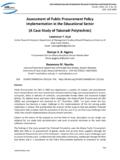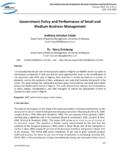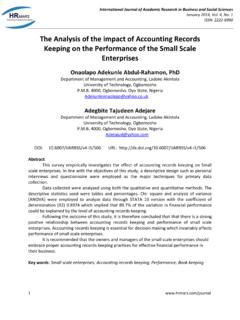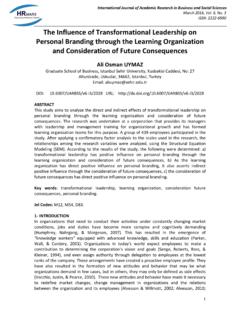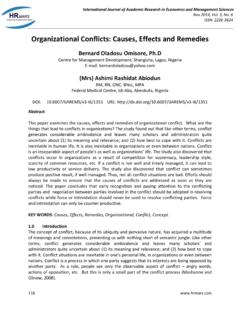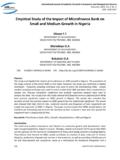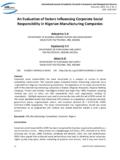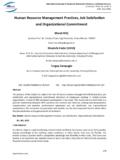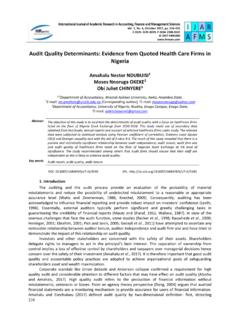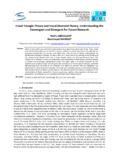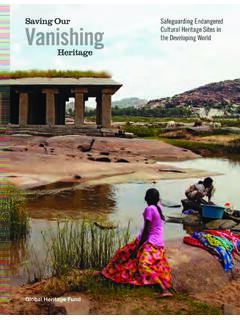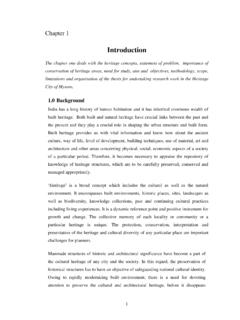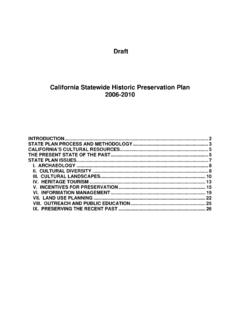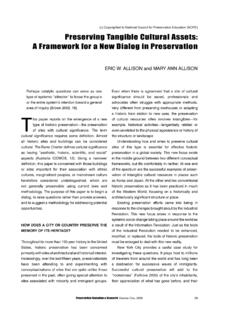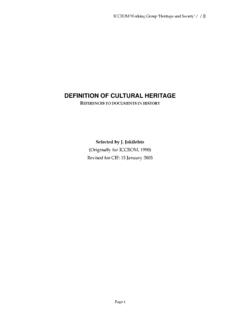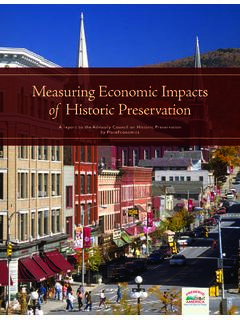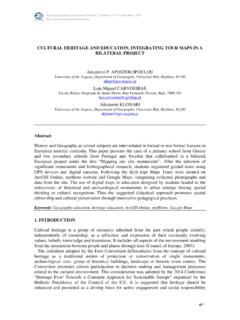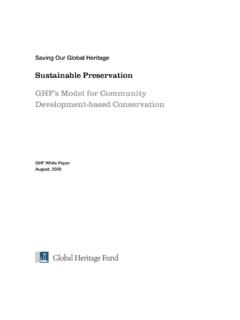Transcription of Cultural Heritage Preservation Methodology: Korean Mask ...
1 International Journal of Academic Research in Business and Social Sciences 2017, Vol. 7, No. 8 ISSN: 2222-6990 431 Cultural Heritage Preservation methodology : Korean Mask Dance Drama Sang Woo Ha Department of Performing Arts, Faculty of Music and Performing Arts Universiti Pendidikan Sultan Idris, Malaysia DOI: URL: Abstract This article discusses the Preservation methodology of South Korean intangible Cultural Heritage through the case of the Cultural Heritage Protection System launched in 1962. Through this system, fifty-seven kinds of intangible Cultural properties have been officially preserved. This research examines the reconstructing methodologies of five traditional mask dance dramas, t alch ums, through literature review and interviews with performers from the Cultural Heritage Protection System. This article will benefit scholars and students in the performing arts seeking the effective methodologies in recovering original versions of ephemeral dance and theatre.
2 Keywords: Preservation methodology , Cultural Heritage Protection System, Korean Mask Dance Drama, T alch um, Ephemeral Performance Introduction The South Korean government passed the Cultural Properties Protection Law in December 1961 and then promulgated it in January 1962. The system classified properties, based on whether or not they are tangible or intangible. Tong-Gw n Lim, Korean folklorist, specifies the classification of the properties, concentrating on the process used to form each property and groups of property to perform and transmit (Lim 1996). According to this logic, tangible properties can be historical sites, castles, buildings, and art works. They include symbols of power associated with the monarchy or the upper classes. Intangible properties involve the performing arts, such as t alch um and nongak (traditional music). This latter category includes Cultural practices performed by the lower classes (Lim 1996).
3 Lim verifies that since the government inaugurated the protection system, common culture began to be acknowledged as part of Korean Cultural Heritage . The governmental publication shows that Cultural properties could be considered the state s economic wealth, yet what the government seems to emphasize was properties historical status and connection to tradition (Minister of Culture and Public Information 1970). The properties become historical creations and valuable parts of the Korean community because, according to the government at this time, they are representatives of national tradition. As the definition of Cultural properties in the official government publication suggests, the state sees itself as being devoted to serving the purpose of protecting Korean traditional culture. For such a reason, the Cultural Heritage Protection System under the International Journal of Academic Research in Business and Social Sciences 2017, Vol.
4 7, No. 8 ISSN: 2222-6990 432 government has revived the original forms of the intangible Cultural properties like t alch um by focusing on reconstructing processes that were guided by the government-affiliated research scholars and performers in the Preservation societies. The crucial point to notice here is how the Cultural Heritage Protection System reconstructed live (or called intangible and ephemeral) performances by naming the authorized piece Wonhyeong [ : original form]. The system used reconstructing procedures much like those that dance historians like Millicent Hodson utilized in the 1970s and 1980s. These processes emphasize duplication of past sequences of movement, music rhythms, and garment designs that re-imagine performance s past. The following discuss section will analyze similarities between the Cultural system s standardization methods and Hodson s reconstructing procedures.
5 The Korean Cultural system did not simply endeavor to duplicate pre-existing premieres of t alch um. Rather, it created the standardized the mask dance dramas that would have boundless potentials for change and omission depending on whenever new sources discover and add. Background: The Cultural Heirtage Protection System of South Korea Strengthening the Cultural administrative agency, the government not only appointed Korean scholars as the system s research committees in March of 1962, but also assigned some folklorists as Cultural properties specialists for each field theater, music, dance, handicraft, folk amusement, folk religion, folk rite, and so on in May of the same year (Jung 2008). The most of the selected committees and specialists came from the Korean Society for Cultural Anthropology established in 1958.
6 In October 1962, they began conducting research on current conditions of the properties, which could be seen as the intangible Heritage , and designated the studied properties in February 1964. T alch um was classified as the folk theater field in the protection system. Du-Hyeon Lee and Seok-Jae Im was the main researchers and identified thirteen t alch ums at that time (Jung 2008). These research scholars discoveries became fundamental sources to register the mask dance dramas as intangible Cultural properties. That is, the research scholars were involved in and significantly influenced the system of intangible Cultural properties by administratively and academically selecting and managing the properties. Along with the research scholars, performers in t alch um Preservation societies, no doubt, were significant players in the Cultural Heritage Protection System.
7 In the initial stage of the system, today s Preservation societies did not exist. While starting the investigation project in 1968, Hanguk Minsok Jonghap Josa ( Korean National Total Investigation), the scholars discovered some folklore groups who continued to perform the mask dance dramas as village activities. Based on the investigation from 1968 to 1980, the scholars decided whether or not the village folklore groups were performing intangible properties. The system-headed project also decided whether or not professional performers were still active in the groups ( Korean Cultural Heritage Research Laboratory in Chungang University 2011). The Preservation society system for intangible performances was launched on December 31, 1982. In 1986, the village folklore groups were eventually appointed as Cultural gatekeepers and were officially named the Preservation societies as the affiliated groups of the Preservation system.
8 Since then, International Journal of Academic Research in Business and Social Sciences 2017, Vol. 7, No. 8 ISSN: 2222-6990 433 members in those societies have been fully responsible to annually performing and continuously transmitting the mask dance dramas with financial support of the system. Literature Review and Research Objective Since the 1960s, performing arts fields, including dance and theatre, have heated up the debates about whether or not live but intangible performances from ephemerality are saved. Rebecca Schneider is one of the important scholars focusing on this topic. Schneider in Theatre Criticism mentions that every other art has its original and its copies ; however, the peculiar burden and problem of the theater is that there is no original artwork at all. She goes on to say that unless one maintains that the text is the art work which repudiates the entire history of the theater, there seems no way of avoiding this difficult fact (Schneider 1965).
9 In another book Between theatre and Anthropology, she also points out performance originals disappear as fast as they are made. [..] One of the chief jobs challenging performance scholars is the making of a vocabulary and methodology that deal with performance in its immediacy and evanescence (Schneider 1985). Schneider s arguments are able to be supported by the statements of two scholars, Herbert Blau and Marcia Siegel as follows respectively: In theater, the subject is disappearance and Dance exists as a perpetual vanishing point (Balu, 1982; Siegel, 1968) The wordings of these three dance and theatre scholars demonstrate that academic discussion about the disappearance of live performance has existed in performing arts studies while researchers followed the conventional way to document. Such a discussion enables scholars to seek for a new methodology of saving intangible performances.
10 Even though books and articles about the Korean Cultural Heritage Protection System have been published, they do no more than the introduction of the whole system. That is, even though the methodology in the protection system can be seen as the main vehicle of catching up ephemeral movements like mask dance dramas, no one has mentioned it. In 1984, Korean scholar Gyeong-Uk Jeon published his writing about how mask dance dramas are preserved under the protection system. His book contained several scripts of the mask dance dramas, but it still missed the specific explanation about what methods Korean researchers created those scripts through. Diana Taylor, expert on performance studies, responds to the discussion about safeguarding live performances in a similar vein, which is what the writer wants to address. Taylor argues that intangible performances cannot be fixed only in textual descriptions because they often involve corporeal nature and meanings that are coming from the context in which performers actions take place.
